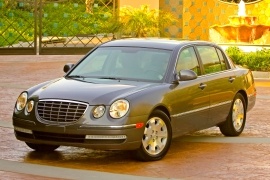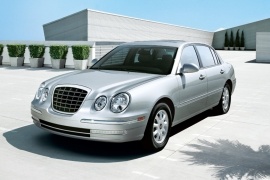KIA Opirus / Amanti Models/Series Timeline, Specifications & Photos
First production year: 2003
Engines: Gasoline
Kia refreshed in 2007 its flagship sedan model, the Opirus/Amanti, bringing more luxury and safety features in standard trim, while others were available as an option.
With a redesigned front-fascia, Kia hoped that it might get more customers into its showrooms to get an executive sedan. It was an interesting offer, with a good price/value factor but a design that could have been better. Way better.
On the outside, the addition of LED daytime running lights was welcomed by everyone, but the dual headlights system that resembled the old Mercedes-Benz E-Class W210 was not an appreciated part of the car. The grille sported a grid-pattern that some could think was inspired by Cadillac. On top of that, there was no Kia badge at the front. In the back, the new taillights design featured vertical lines for the brakes and turn signals, while the bumper sported two exhausts mounted on the sides.
Inside, there was a new trim option with black leather and black trims. Also, the carmaker tried to offer better wood-plastic trims on the dashboard and door panels. Its new sound system and improved buttons on the steering wheel showed better quality than before.
Under the hood, Kia asked Mitsubishi for help, and the Japanese carmaker offered them a 3.8-liter V-6 engine paired to a five-speed automatic transmission. This unit came to complete the three engines lineup.
Based on the same platform as the Hyundai XG350, the Opirus/Amanti was introduced as Kia's flagship model in 2003 at the Geneva Motor Show.
The carmaker said that it produced the car for the 40-to-60-year-old professionals and put all the bells and whistles it had in its shop. Too bad that it didn't invest more in the design department, though, since the car showed a Jaguar S-Type – Mercedes-Benz E-Class-inspired front fascia and a rear side that resembled a Lincoln Town Car.
At the front, the four round headlights that flanked the shield-styled grille shook the market. But that design made the car very easy to recognize in traffic. Its cab-rearward design with a raked windshield and almost vertical rear windscreen induced the idea of a rear-wheel-drive vehicle, even though it was front-wheel-drive. In the back, the horizontal taillights crossed from the rear quarter panels to the trunk lid, with the reversing lights on the corners.
Inside, Kia installed wood trims on the dashboard, door panels, and center stack, creating an upmarket image for a car that was 30% cheaper than a Mercedes-Benz E350. The carmaker offered the vehicle in a single trim level for the American market, with a leather-clad interior, automatic climate control, heated front seats, and a premium CD-cassette-radio sound system. For other countries, the Opirus/Amanti was available with heated and reclining rear seats. Since it had a longer wheelbase than the Hyundai XG, it offered more legroom for the rear passengers.
Under the hood, the Opirus/Amanti was available with a few engine choices. The U.S. market received only the Mitsubishi-licensed 3.5-liter V6 paired to a five-speed automatic.

